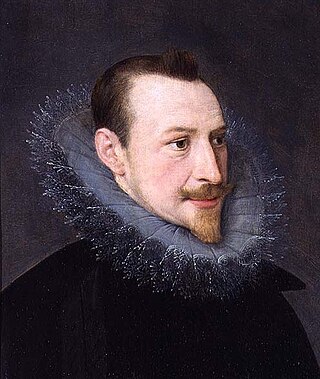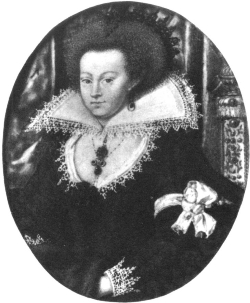Related Research Articles

Edmund Spenser was an English poet best known for The Faerie Queene, an epic poem and fantastical allegory celebrating the Tudor dynasty and Elizabeth I. He is recognized as one of the premier craftsmen of nascent Modern English verse, and he is considered one of the great poets in the English language.
This article presents lists of literary events and publications in the 16th century.
This article contains information about the literary events and publications of 1596.

Mary Herbert, Countess of Pembroke was among the first Englishwomen to gain notice for her poetry and her literary patronage. By the age of 39, she was listed with her brother Philip Sidney and with Edmund Spenser and William Shakespeare among the notable authors of the day in John Bodenham's verse miscellany Belvidere. Her play Antonius is widely seen as reviving interest in soliloquy based on classical models and as a likely source of Samuel Daniel's closet drama Cleopatra (1594) and of Shakespeare's Antony and Cleopatra (1607). She was also known for translating Petrarch's "Triumph of Death", for the poetry anthology Triumphs, and above all for a lyrical, metrical translation of the Psalms.

Elizabethan literature refers to bodies of work produced during the reign of Queen Elizabeth I (1558–1603), and is one of the most splendid ages of English literature. In addition to drama and the theatre, it saw a flowering of poetry, with new forms like the sonnet, the Spenserian stanza, and dramatic blank verse, as well as prose, including historical chronicles, pamphlets, and the first English novels. Major writers include William Shakespeare, Edmund Spenser, Christopher Marlowe, Richard Hooker, Ben Jonson, Philip Sidney, Thomas Kyd, and Richard Barnfield.
Thomas Watson (1555–1592) was an English poet and translator, and the pioneer of the English madrigal. His lyrics aside, he wrote largely in Latin, also being the first to translate Sophocles's Antigone from Greek. His incorporation of Italianate forms into English lyric verse influenced a generation of English writers, including Shakespeare, who was referred to in 1595 by William Covell as "Watson's heyre" (heir). He wrote both English and Latin compositions, and was particularly admired for the Latin. His unusual 18-line sonnets were influential, although the form was not generally taken up.
Nationality words link to articles with information on the nation's poetry or literature.
Nationality words link to articles with information on the nation's poetry or literature.
— Last lines from William Shakespeare's Sonnet 18, published this year and, four centuries later, still "eternal lines"
Nationality words link to articles with information on the nation's poetry or literature.
Robert Tofte was an English translator and poet. He is known for his translations of Ariosto's Satires and his sonnet sequences Alba, The Months Minde of a Melancholy Lover (1598) and Laura, The Toyes of a Traveller: Or, The Feast of Fancie (1597). He also authored a partial translation of Boiardo's Orlando Innamorato and was possibly responsible for the popular and anonymous Batchelar's Banquet (1603) as well. Tofte is perhaps most famous for his incidental reference to Love's Labour's Lost in Alba, the first mention of that Shakespeare play in print.
Nationality words link to articles with information on the nation's poetry or literature.
— From Sir John Harington, A New Discourse of a Stale Subject, called the Metamorphosis of Ajax
Nationality words link to articles with information on the nation's poetry or literature.
Nationality words link to articles with information on the nation's poetry or literature.
Nationality words link to articles with information on the nation's poetry or literature.

Nationality words link to articles with information on the nation's poetry or literature.

Colin Clouts Come Home Againe is a pastoral poem by the English poet Edmund Spenser and published in 1595. It has been the focus of little critical attention in comparison with the poet's other works such as The Faerie Queene, yet it has been called the "greatest pastoral eclogue in the English language". In a tradition going back to Petrarch, the pastoral eclogue contains a dialogue between shepherds with a narrative or song as an inset, and which also can conceal allegories of a political or ecclesiastical nature.

Elizabeth Spencer, Baroness Hunsdon was an English noblewoman, scholar, and patron of the arts. She was the inspiration for Edmund Spenser's Muiopotmos, was commemorated in one of the poet's dedicatory sonnets to The Faerie Queene, and was represented as "Phyllis" in the latter's pastoral poem Colin Clouts Come Home Againe. She herself translated Petrarch. Her first husband was George Carey, 2nd Baron Hunsdon, grandson of Mary Boleyn, elder sister of Anne Boleyn, mother of Queen Elizabeth I.
The Model of Poesy (1599), by William Scott, is a Renaissance-era, English literary treatise about the art of poetry, which presents a theoretical description of what is poetry, and practical guidelines about how to write well. Proceeding from An Apology for Poetry (1595), by Philip Sidney, The Model of Poesy develops Scott's poetics in the classical and continental traditions, using examples from Geoffrey Chaucer and Edmund Spenser, William Shakespeare and quotations from Scott's partial, English translation of the French La Sepmaine (1578), by Guillaume de Salluste du Bartas.
References
- ↑ "Isabel de Urbina". Encyclopædia Britannica . Retrieved 2013-02-01.
- ↑ Temčinas, Sergejus (2013). "Pirmoji Lietuvos Didžiojoje Kunigaikštijoje lietuviškai spausdinta (katalikiška) knyga: hipotetinis 1585 metų ar Mikalojaus Daukšos 1595 metų katekizmas?". In Bumblauskas, Alfredas; Potašenko, Grigorijus (eds.). Lietuvos Didžiosios Kunigaikštijos istorijos ir tradicijos fenomenai: tautų atminties vietos (in Lithuanian). Vilnius: Vilniaus universiteto leidykla. pp. 62–79. ISBN 978-609-459-221-8.
- ↑ Justus Lipsius (2004). Politica: Six Books of Politics Or Political Instruction. Uitgeverij Van Gorcum. p. 126. ISBN 978-90-232-4038-9.
- ↑ Craig, D.H. (1986). "A Hybrid Growth: Sidney's Theory of Poetry in An Apology for Poetry." In Arthur F. Kinney, ed. Essential Articles for the Study of Sir Philip Sidney, Hamden: Archon Books.
- ↑ "PDF Copy available here" (PDF). Archived from the original (PDF) on 2010-06-21. Retrieved 2010-04-12.
- ↑ Copy available here.
- ↑ Maxwell, Baldwin (1956). Studies in the Shakespeare Apocrypha. New York: King's Crown Press. pp. 39–63.
- ↑ John Payne Collier (1820). The Poetical Decameron Or the Conversations on English Poets and Poetry. pp. 67.
- ↑ Ruoff, James E. (1975-11-11). Macmillan's Handbook of Elizabethan & Stuart Literature. Macmillan International Higher Education. p. 29. ISBN 978-1-349-02793-4.
- ↑ Edmund Spenser (1873). The Works of Edmund Spenser: Complaints (concluded). Colin Clouts come home againe. Foure hymnes. Daphnaida. Prothalamion. Sonnets. Britain's Ida. A view of the state of Ireland. Glossary. p. 66.
- ↑ A. L. Dallapiccola (30 September 2006). Indian love poetry. Interlink Books. p. 90.
- ↑ Johann Wolfgang von Goethe (1979). Torquato Tasso: A Play. Manchester University Press. p. 4. ISBN 978-0-7190-0720-0.
- ↑ John Platts (1826). A Universal Biography: Containing Interesting Accounts, Critical and Historical, of the Lives and Characters, Labours and Actions, of Eminent Persons in All Ages and Countries, Conditions and Professions. Sherwood, Jones & Company. p. 674.
- ↑ Encyclopaedia Britannica: First Published in 1768 by a Society of Gentlemen in Scotland. Encyclopaedia Britannica. 1973. p. 145. ISBN 978-0-85229-173-3.